Gawsworth
OS Grid ref:-
The charming village of Gawsworth lies to the south west of Macclesfield. The authors of the Buildings of England series state of the village, 'There is nothing in Cheshire to compare with the loveliness of Gawsworth: three great houses and a distinguished church set around a descending string of pools, all within an enigmatic large-scale formal landscape.'
Gawsworth Old Hall from across the lake
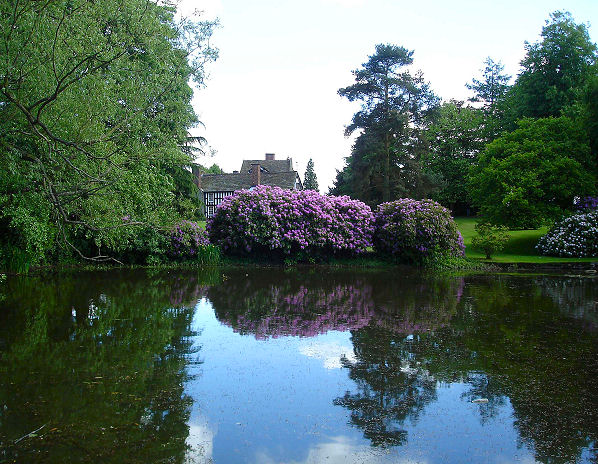
Gawsworth Old Hall is a late fifteenth century half timbered manor house built around a courtyard. The house belonged to the Fitton family, Earls of Macclesfield. The hall contains many fine paintings, furniture, sculpture and stained glass.
Gawsworth New Hall was begun by Lord Mohun in 1707 but abandoned after he was killed in a duel with the Duke of Hamilton in 1712 (see below) . Later additions and alterations were made including those to the designs of Sir Hubert Worthington in 1914. The new hall is not open to the public and is owned by the Richards family, who also own the Old Hall.
Gawsworth New Hall and the view across the lake
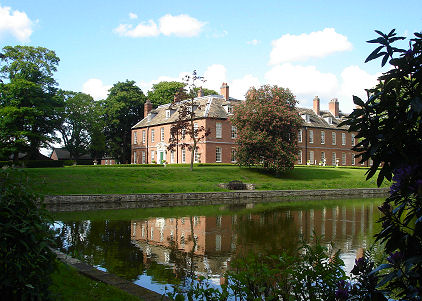
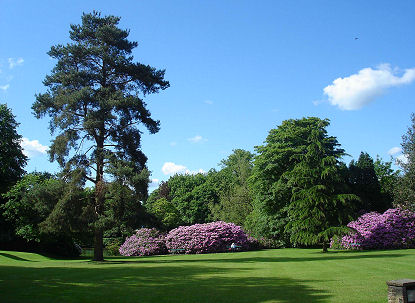
Gawsworth Old Rectory dates back to about 1470, the north wing was added in 1872. The house is timber-framed, and it retains its hall open to the roof. It is described as "one of the best preserved medium-sized houses of the period in Cheshire, particularly valuable for the survival of the open hall".
The church of St.James, Gawsworth
The church of St James dates from the fifteenth century. The oldest part of the building is the nave which was built in 1430. The tower and chancel were added some 40 years later. The rafter beam ceiling of the nave dates from the fifteenth century and retains some of its original brilliant colouring and gilt. The camber beam chancel ceiling, which is panelled, dates from slightly later. The octagonal font is sixteenth century. Fragments of ancient glass are to be found in the chancel windows.
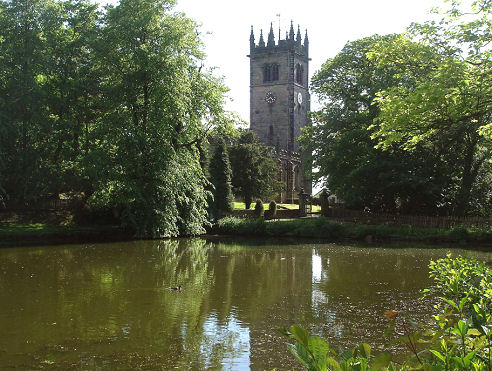
In the chancel are four tombs of members of the Fitton family of Gawsworth Hall. The oldest of these is an altar tomb to Francis Fytton dated 1608. Opposite this is the monument to Dame Alice Fitton who died around 1626. In front of her seated effigy are effigies of her two sons kneeling, and behind her are figures of her two daughters, also kneeling. Adjacent is the tomb of Sir Edward Fitton, 1st baronet, and his wife Anne, who died in 1619 and 1644 respectively. In front of the tomb are the keeling figures of their three sons and seven daughters. One of the daughters was Mary, a maid of honour to Queen Elizabeth I and a candidate for the mysterious "Dark Lady" of Shakespeare's sonnets. The fourth tomb is to the memory of Sir Edward Fitton, 2nd baronet, who died in 1643, and his first wife Jane.
The Famous Duel of Lord Mohun and the Duke of Hamilton
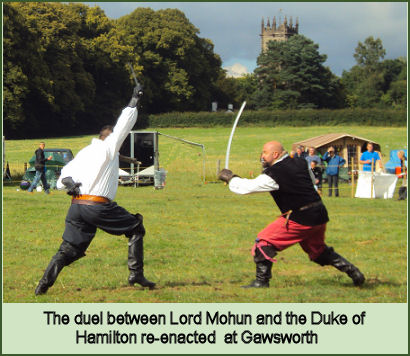 At the end of the English Civil War, a long drawn out legal battle between Sir Charles Gerard (later the 1st Earl of Macclesfield) and Alexander Fitton began over the Gawsworth estates.
At the end of the English Civil War, a long drawn out legal battle between Sir Charles Gerard (later the 1st Earl of Macclesfield) and Alexander Fitton began over the Gawsworth estates.
They eventually reached agreement over the matter in 1663, but dispute between the families arose again in 1701 with the death of Fitton Gerard (the 3rd Earl of Macclesfield) who left no direct male heirs, disagreement had arisen over who should succeed to his extensive estates, based at Gawsworth Hall. The estate was left to a niece, Lady Mohun, but her inhertence was contested by another niece, the Duchess of Hamilton.
It was this dispute that culminated in probably the most famous duel in English hstory between Charles, 4th Baron Mohun and Sir James Douglas-Hamilton, 4th Duke of Hamilton in 1712, during the course of which both combatants were killed.
Shortly before Hamilton was due to leave for France, Mohun challenged him to a duel. The duel took place at 7a.m on Sunday 15th of November, 1712 at Hyde Park in London. A fierce fight ensued with both men fighting "like enraged lions." After killing Lord Mohun, the Duke of Hamilton was killed by Mohun's second, George MacCartney, who later fled the country. Both seconds, MacCartney and Hamilton's, Colonel John Hamilton, escaped and were tried in absentia for murder, but were both later pardoned.
This bloody duel was made immortal by William Makepeace Thackeray in his novel The History of Henry Esmond. The injuries suffered by the two men were so horrific that the government passed legislation banning the use of seconds in such duels. Also as a result swords were replaced as the weapons of choice in duel by the pistol, which tended to result in shorter and less bloody fights.
Nearby places of interest
Capesthorne Hall, one of the premier country houses in Cheshire, stands at Siddington in East Cheshire which is five miles west of Macclesfield. The hall has been the family home of the Bromley-Davenport family since 1726.
Macclesfield Forest was once the centre of a Royal Forest created by the Norman kings for the purpose of hunting game such as deer, wild boar and wolves. It once encompassed all the area from Disley to the River Dane. The forest is home to a herd of red deer, while the reservoirs contain a wide variety of wildfowl.
